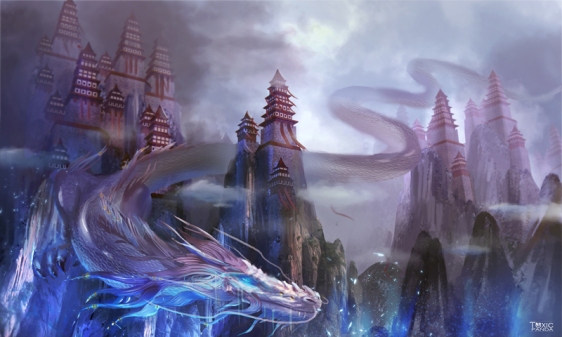You may be under the impression that the Fantasy Artist, would be confined by their “choice of techniques” – especially with regard to the location, of their Fantasy Realm. Yet, when it comes to Tales of Fantasy – can it be seen, that this not entirely true 🙂 Even more so, when that Fantasy Realm – is that of King Arthur, and his Knights of the Round Table:

King Arthur – and his Knights of Camelot
I feel that this artist, has decided to “play with us”. First: in terms of perspective. This Fantasy scene exhibits the behaviour of a one point perspective – as everything tends towards the Castle Gate. Yet, as we shall see, it is not quite as simple as that! For the Walls of this Castle, appear to be curved (except for around the base of the Gate Pillars). If we assume that the bottom of the Gate Pillars are a “base line” (with an Anchor Point at either end), then it seems to me – that this Fantasy artist, has chosen to “mix in” a Fish Eye Perspective. Yet, as we shall see, it is not quite as simple as that! For the curved perspective lines appear to “sweep in”, from the top right of the drawing (which does not meet the definition of a standard Fish Eye Perspective [which would be more like a ball, with it’s lines “sweeping” the other way]). Thus, do we have a Fantasy artist making use of techniques (the altered Fish Eye Perspective), within a Fantasy Realm that you might not expect – that of King Arthur, and his Kingdom of the Land (as opposed to the Sea). Second: In terms of location. The foreground parts of this Fantasy scene, appear to be of the Dark. There’s Mountainous Rocks, with jagged edges. There’s hard of Ice, with slippery slopes. There’s swirling winds, with blizzard Snow. Whilst the background parts of this Fantasy art, appear to be of the Light. There’s Castle Spires, with whitened Walls. There’s Towering Structures, with Glowing Gleam. There’s Spheres of Moon, with turquoise Haze. Which when taken together, feels as though this Castle (and it’s Knights) are “Braced against the Dark”. Perhaps this Castle and it’s Knights, have been besieged for months – and have chosen to, ride out against the Dark? Third: In terms of “pun”. When the Fish Eye Perspective, and the Light against Dark theme are “taken together”; do I find the concept of a Round Table. The curvature of the Castle, is akin to the “longer edge” – of Arthur’s Round Table. The fight between Light and Dark, is akin to the “never ending cycle” – of the Knights of the Round Table. Finally: it’s just possible, that this Kingdom has travelled in Time – as it seems as though the lighter sky, has been overlaid in “Moon Time” (especially at the central top of the image [tending towards the turquoise Haze]).


